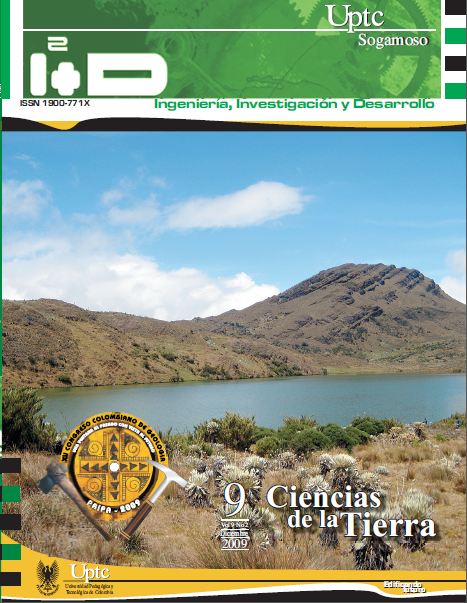Geological evaluation and prospectivity, Cauca – Patía basin, Colombia

Abstract
The Cauca-Patía Basin (CPB) is an intermountain depression which separates Colombia’s Central and Western mountain chain. The Alto de Popayán borders the Cauca Subbasin, to the north, and from the Patía Subbasin, to the south. The former is mainly covered by quaternary alluvial deposits. In the southwest margin there is an outcrop of sedimentary rocks from the Palaeogene. On the contrary, in
the the Patía Subbasin mainly appear folded and faulted rocks from the Palaeogene and the Neogene. Margins are formed by regional reverse and strike slip faults. Towards the inner part of the CPB, inverse faults of the Late Miocene with westward vergence are generally found. The CPB was formed by the collision and accretion of oceanic terrains on the west margin of the South American Plate during the Mesozoic and Cenozoic periods. Chimborazo, Ferreira, Mosquera and Cinta de Piedra Formations, as well as some levels of the Guachinte Formation (Late Palaeocene to the Mid Miocene) are grain-coarse clastic units (sandstones and conglomerates) which can be potential reservoir rocks. Aguaclara, Peñamorada and Chimborazo Formations (Upper Cretaceous and Lower Eocene) have levels of good characteristics to generate hydrocarbons. (%TOC > 1 and Hydrogen index values > 300 mgHC/gTOC) and type II kerogen. To the south of the basin there are two oil seeps in the Matacea creek, Mercaderes town. Volcaniclastic deposits from Galeón and La Paila Formations, and locally, levels of intra- formational clays which are present in all reservoirs may be regional seal. Traps associated to folds due to fault propagation folding are observed in the Patía Subbasin. In the case of the Cauca Subbasin, the structural style is associated to block tectonics which affects the basement. The types of traps are related to stratigraphic pinch outs and cut-offs against reactivated normal and inverse faults. There is an additional exploratory opportunity in the Cauca Subbasin related to the presence of carbons in the Guachinte formation; and the possibility of methane gas associated to the foresaid carbons.
Keywords
basin, source rock, reservoir rock, seal rock, hydrocarbons, traps
References
- Barrero-Lozano, D.; Laverde, F.; Ruiz, C., and Alfonso, C.A. (2007): Oblique collision and basin formation in western Colombia: the origin evolution and petroleum potencial of Cauca – Patía Basin.
- Barrero-Lozano, D. and Laverde, F. (1998): Estudio integral de evaluación de la geología y potencial de hidrocarburos de la cuenca “intramontana” Cauca Patía. ILEX para Ecopetrol, Informe,p. 83.
- Campbell, C.J. and Velasco, G. (1965): The Geology and oil prospects oftheCaucaBasin,Colombia.Sinclair and BPcolombian Inc.internalreport.100p.
- Core Laboratories. (1989): Oil seep characterization Cauca-Patía area. Job number 89056. 23 p.
- Ego, F.; Sébrier, M.; Lavenu, A.; Yepes, H., and Egues, A. (1996): Quaternary state of stress in the northern Andes and the restraining bend model of the ecuadorian Andes. Tectonophysics 259, 101–116.
- Geochem Laboratories Inc. (1981): Geochem Job No. 1834, Patia Basin.
- Mantilla, A. and Arias, J. (2001): Síntesis regional y caracterización estructural de la Subcuenca del Patía. OAKS Asociados Ltda. 74 p.
- Maya, M. and González, H. (1995): Unidades litodémicas en la Cordillera Central de Colombia. Boletín Geológico INGEOMINAS, 35, 43-57.
- Moreno, M. and Pardo, A. (2003): Stratigraphical and sedimentological constraints on western Colombia: implications on the evolution of the Caribbean plate, in C. Bartolini; R. T. Buffler, and J. Blickwede, (eds.), The Circum-Gulf of Mexico and the Caribbean: hydrocarbon habitats, basin formation and plate tectonics: AAPG Memoir 79, pp. 891– 924.
- Pérez, G. and Numpaque, L. E. (1980): Cuenca del Patía Superior. Informe geológico Ecopetrol. 33 p.
- Pindell, J.; Kennan, L.; Stanek, K. P.; Maresch, W. V., and Draper, G. (2006): Foundations of Gulf of Mexico and Caribbean evolution: eight controversies resolved. Geologica Acta, Vol. 4, No. 1-2, 303-341.
- Rangel, A.; Goncalves, F., and Escalante. C. (2002): Organic geochemical evaluation of the Patia Basin, Colombia: assessing the petroleum system of a frontier area. CT&F – Ciencia, Tecnología y Futuro, Vol. 2, No. 3, pp. 5-17.
- Sinton, C.W.; Duncan, R. A.; Storey, M.; Lewis, J., and Estrada, J. J. (1998):An oceanic flood basalts province within the Caribbean plate: earth and planetary science letters, v. 155, p. 221-235.
- Vlierboom, F.W. (1989): Geochemical evaluation of three outcrop samples and two surface seep samples, Cauca Patía, Colombia, pp. 89.